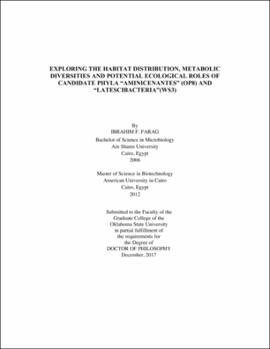| dc.description.abstract | The overall goal of this study is to investigate the ecological distribution patterns, metabolic capabilities and physiological preferences of two yet uncultured bacterial phyla: The "Aminicinantes (previously called OP8) and the "Latescibacteria" (previously called WS3"). To this end, three different research projects were conducted. In the first project, we utilized 16S rRNA gene sequences available in public databases to explore the global patterns of abundance, diversity, and community structure of members of the "Aminicenantes". Our analyses revealed that "Aminicenantes" exhibits highest levels of relative abundance in hydrocarbon-impacted environments, followed by marine habitats, and aquatic, non-marine habitats. Notable preferences of members of the "Aminicenantes" to hypoxic/anoxic, as well as non-saline/low salinity habitats were also observed. Distinct patterns of "Aminicenantes" community structures were observed; and such patterns appear to be driven by habitat variations rather than prevalent environmental parameters. In the second project, a detailed genomic analysis and metabolic reconstruction effort was conducted to investigate the metabolic potential and ecological roles of four single cell derived genomes that belonging to the Latescibacteria". Metabolic reconstruction suggested that these cells possess an anaerobic fermentative metabolism, as well as the capability to degrade multiple polysaccharides and glycoproteins that are components of green (Charophyta and Chlorophyta) and brown (Phaeophycaea) algae cell walls. Further, the analyzed genomes suggest the ability to produce bacterial microcompartment (BMC) to sequester toxic intermediate produced during fucose and rhamnose metabolism. As well, genes for the formation of gas vesicles, flagella, type IV pili, and oxidative stress response were also identified. In the third project, we investigated the pangenomic diversity of the candidate phylum "Latescibacteria" (WS3) in a wide range of metagenomic data sets using a fragment recruitment strategy. We identified 68.9 Mb of "Latescibacteria"-affiliated contigs in publicly available metagenomic data sets comprising 73,079 proteins. Metabolic reconstruction of this "Latescibacteria" metagenome suggests a prevalent saprophytic lifestyle in all "Latescibacteria" orders, with marked capacities for the degradation of proteins, lipids, and polysaccharides predominant in plant, bacterial, fungal/crustacean and eukaryotic algal cell walls. Interestingly, genes and domains suggestive of the production of a cellulosome were identified in genomic fragments recovered from four anoxic aquatic habitats; hence extending the cellulosomal production capabilities in Bacteria beyond the Gram-positive Firmicutes. In addition to fermentative pathways, a complete electron transport chain with the capacity to operate under high oxygen as well as low oxygen tension was identified in fragments recovered from oxygenated and partially/seasonally oxygenated aquatic habitats. Overall, this work expanded our knowledge regarding the ecology, physiology and metabolic capabilities of two yet-uncultured microbial phyla. | |
